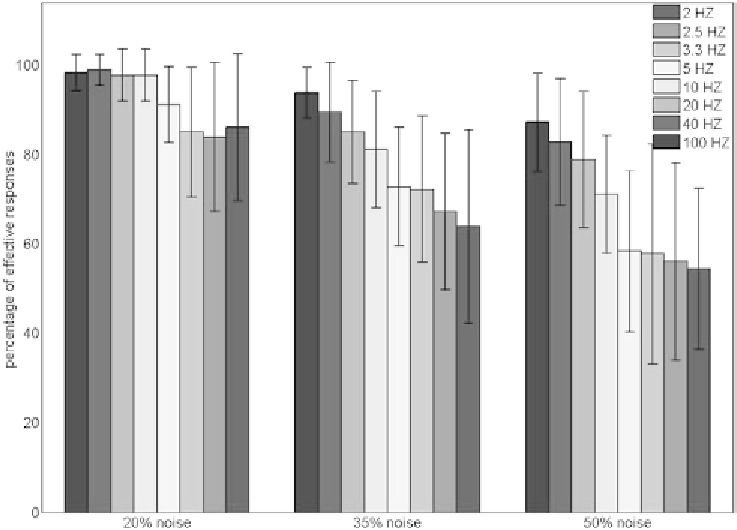Biology Reference
In-Depth Information
Fig. 6. Statistics of effective responses in dopamine signaling systems subjected to noise of various amplitudes and frequencies.
The bars in each group are sorted from left to right by noise frequency [Hz]. The statistics for each bar was calculated from 20
simulation samples.
various crowding effects must be expected to create stochasticity that cannot be ignored in the context
of vesicle dynamics and dopamine release. Because the details of stochasticity in the cytosol cannot be
characterized in mechanistic detail, it seems reasonable to let the simulations account for randomness in
the dopamine flux from the vesicle pool to the synaptic cleft. This section addresses the effects of this
stochasticity with an exploration of noise of different frequencies and amplitudes.
Most processes in dopamine signal transduction are fast, with events such as biochemical reactions
and ion flux transduction lasting from several milliseconds to tens of milliseconds. The randomness of
such fast events results in noise of high frequency which is at the order of about one hundred Hertz. At
the same time, there are also much slower events such as vesicle exocytosis, which may last for one
hundred or more milliseconds and whose stochasticity corresponds to noise of several Hertz in frequency.
Therefore, the frequency of realistic random perturbations ranges from several to hundreds of events per
second (Hz), and it seems that an appropriate amplitude may be up to
+
50% of the baseline. As was
shown in the Methods section, we model the noise by imposing a sequence of discrete Gaussian random
numbers on the rate of dopamine flux. To evaluate the impact of this noise on signaling, we assume
again, for illustration purposes, a threshold of 185% of the DA-e concentration level in comparison to the
baseline (see Fig. 5) and record a response as effective if the actual DA-e level surpasses this threshold.
As an example, we use the dopamine model again under a train of 10 signals characterized by
w
1
=
0.01s,
w
2
=
0.2s and
bolus
=
20. When the signaling system is not subjected to noise, it always yields
nine effective responses. The first response does not reach the threshold and is therefore not deemed
effective. This “omission” may serve in the system as a filter that effectively ignores spurious firing. If
the system is corrupted by noise, signal responses may be amplified or diminished, or they may merge

